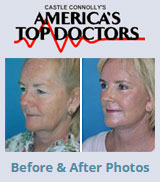On 08
Nov
2010

Reprinted from DERMATOLOGY TIMES, OCTOBER, 2006
Rejuvenating the Aging Perioral Complex Region
By Ilya Petrou M.D. Staff Correspondent
Quickread: There are various surgical and non-surgical procedures used in cosmetic surgery today to effect a rejuvenation of the perioral region. Here, one cosmetic surgeon offers some pearls on which surgical techniques work best to maximize positive aesthetic results.
 Toronto - Cosmetic surgery today has become a household term with business booming more than ever, worldwide. The strong desire of patients to look young and younger has always been present, but in today´s world, it has become almost fashionable to have a procedure or two "done" by an entrusted cosmetic surgeon or aesthetic physician. Cosmetic professionals must also therefore keep up with the pace of their patients and their needs, being able to offer their patients state-of-the-art procedures and therapies. From facelifts to fillers, patients today demand only the best. Ross A. Clevens M.D., FACS, head plastic surgeon at The Center for Facial Cosmetic Surgery in Melbourne , Merritt Island , Florida , offered his long years of experience and spoke of his different techniques on how to best rejuvenate and sculpt the aging perioral complex region, at the American Academy of Facial Plastic and Reconstructive Surgery in Toronto , in September.
Toronto - Cosmetic surgery today has become a household term with business booming more than ever, worldwide. The strong desire of patients to look young and younger has always been present, but in today´s world, it has become almost fashionable to have a procedure or two "done" by an entrusted cosmetic surgeon or aesthetic physician. Cosmetic professionals must also therefore keep up with the pace of their patients and their needs, being able to offer their patients state-of-the-art procedures and therapies. From facelifts to fillers, patients today demand only the best. Ross A. Clevens M.D., FACS, head plastic surgeon at The Center for Facial Cosmetic Surgery in Melbourne , Merritt Island , Florida , offered his long years of experience and spoke of his different techniques on how to best rejuvenate and sculpt the aging perioral complex region, at the American Academy of Facial Plastic and Reconstructive Surgery in Toronto , in September.
Dr. Clevens said that, "There are many challenges that the cosmetic surgeon must face when addressing the aging changes of the perioral region. The length of the upper lip, the position of the corners of the mouth, the laxity of the nasolabial folds, the shape and volume of the vermillion, as well as the degree of perioral wrinkling are just some of the aesthetic points to be dealt with when finding ideal solutions and gratifying aesthetic outcomes for my patients."
For practical purposes and to better target and treat specific aesthetic areas, Dr. Clevens divides the face into 3 concentric rings: The outer ring - consisting of the face and neck, the middle ring - bounded by the base of the nose, chin and nasolabial folds, and the inner ring - consisting of the lips and teeth.
He said that in modern cosmetic surgery, there are numerous procedures and techniques at the disposal of the surgeon used to address the aging perioral features. Dr. Clevens said that the non-surgical solutions that he likes to use include cutaneous resurfacing, injectable fillers, fat, implants, and botox. Surgical solutions include corner of the lip lift, subnasal lip lift, direct lip advancement, and direct excision of the nasolabial folds.
"When I perform a direct lip lift, I leave a gap in the region of the pro-labium between the apices of Cupid´s bow. Then I make the strip twice as wide as the desired degree of advancement. Here, there is no need to undermine significantly. Then as always, I finish up with a meticulous multiple layer closure. This method has consistently produced positive aesthetic results," Dr. Clevens explained.
Dr. Clevens uses a corner of the lip lift when addressing the angry or bitter look of the downturned corner of the mouth, elevating the corner of the lip. His simple and very effective technique consists of a 12-16 mm incision along the vermillion-cutaneous border Here, 60%-90% of the length of the nasolabial fold is involved.) He then draws a tangent to the lateral canthus or superior helix that extends 60-90% of the length from the corner of the lip to the nasolabial fold along the tangent. The result is a minimum degree of elevation of 3 mm. Dr. Clevens stresses not to over-undermine the tissue, and finishes with a meticulous multiple layer closure.
Dr. Clevens opts for a subnasal lip lift, when intending to shorten the long upper lip of aging. He said that this procedure allows the upper teeth to show again when the lips are slightly parted, effecting a more youthful look. He said that the major advantage with this procedure is that the scar between the shadowed crease of the nostril sill and lip is virtually imperceptible. The disadvantage though, is that there is a central elevation of the upper lip, and the downturned corners of the mouth are not corrected.
"The aging nasolabial folds are not adequately improved by a facelift or a midface lift. In certain cases, therefore like to perform a direct excision of the nasolabial folds for optimal cosmetic results as an alternative to a filler or a fascial graft at the time of facelift. In my technique, I place the incision just medial to the nasolabial fold, and begin and end the incision in a concavity rather than a convexity. Sometimes I find it sufficient to just excise the lower portion of the nasolabioal fold. I then follow up a repair with a superolateral vector to achieve a lift of the commissure. This technique has proven itself time and time again to yield very positive cosmetic results," Dr. Clevens remarks

